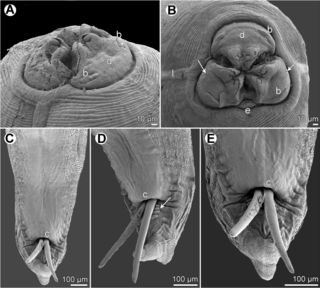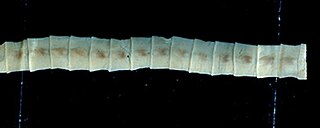
Strongyles, or alternatively, strongyls, are nematode worms of the family Strongylidae, order Strongylida. They are often parasitic in the gastrointestinal tract of mammals, especially grazers such as sheep, cattle and horses.

The Anisakidae are a family of intestinal nematodes (roundworms). The larvae of these worms can cause anisakiasis when ingested by humans, in raw or insufficiently cooked fish.
Tetrameridae is a family of spirurian nematodes. It is the smallest of the large genera making up the bulk of the superfamily Habronematoidea. Like all nematodes, they have neither a circulatory nor a respiratory system. They are parasites, chiefly of birds and cetaceans.

Plagiorchiida is a large order of trematodes, synonymous to Echinostomida. They belong to the Digenea, a large subclass of flukes. This order contains relatively few significant parasites of humans.

Echinorhynchus is a genus of acanthocephalan parasitic worms. They parasitize a wide variety of fishes from both marine and fresh waters. The intermediate host is usually a crustacean.
Arhythmacanthidae is a family of parasitic worms from the order Echinorhynchida.

Rhadinorhynchidae is a family of parasitic worms from the order Echinorhynchida.

Heterophyidae is a family of intestinal trematodes in the order Plagiorchiida.

Opecoelidae is a family of trematodes. It is the largest digenean family with over 90 genera and nearly 900 species, almost solely found in marine and freshwater teleost fishes. It was considered by Bray et al. to belong in the superfamily Opecoeloidea Ozaki, 1925 or the Brachycladioidea Odhner, 1905.
Decemtestis is a genus of trematodes in the family Opecoelidae. It has been synonymised with Allodecemtestis Hafeezullah, 1970.

Helicometra is a genus of trematodes in the class Opecoelidae. It is synonymous with AllostenoperaBaeva, 1968, MetahelicometraYamaguti, 1971, and StenoperaManter, 1933. Its type species is H. fasciata(Rudolphi, 1819). They are distinguished by their unique spiral uterus, from which their name is derived.
Caudotestis is a genus of trematodes in the family Opecoelidae.
Andracantha is a genus of parasitic worms belonging to the family Polymorphidae.

Euterranova is a genus of parasitic nematodes that have life cycles involving elasmobranchs. The genus was created in 2020 to accommodate species which were previously included inTerranovaLeiper & Atkinson, 1914 a taxon considered to be invalid.

Neoterranova is a genus of parasitic nematodes that have life cycles involving sharks and reptiles. The genus was created in 2020 to accommodate species which were previously included inTerranovaLeiper & Atkinson, 1914 a taxon considered to be invalid.

Corynosoma is a genus of parasitic worms belonging to the family Polymorphidae.
Hemiuridae is a family of trematodes belonging to the order Plagiorchiida containing 514 described species.

Bothriocephalus is a genus of flatworms belonging to the family Bothriocephalidae.
Acanthatrium is a genus of flatworms belonging to the family Lecithodendriidae.
Tetrabothrius is a genus of flatworms belonging to the family Tetrabothriidae.











